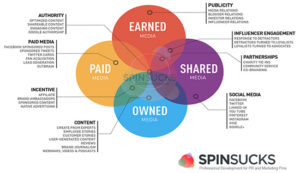Since 2014, industry professionals have been encouraging the implementation of an integrated model, making use of paid, earned, shared and owned media (PESO) altogether. But, some PR professionals have been slow to adopt the PESO model (via Spin Sucks)– many for fear of blurring the lines between editorial and advertising, others for fear of violating the PRSA Code of Ethics, and some for simply not understanding it.
But now, many clients and prospects expect their communication partners to be capable of running successful campaigns using all four elements. Here, we will break down how each type of media works seamlessly in a comprehensive PR program.

Paid Media
This first element is often where lines feel blurred to us PR pros. But fear not – according to the Code of Ethics, as long as the paid placement is transparent, and the audience can readily discern between sponsored content and editorial, then it is in compliance. (Ever see a media kit for a trade publication, though, that offers “native” article placement for $5,000 that’s meant to be disguised as earned media? Yeah, steer clear of those!)
So, what does this mean for a PR program? It means sponsored content (yes, advertorials are okay as long as it is explicitly clear it is a sponsored piece) and social media advertising.
Not long ago, Facebook algorithms favored organic content. But now, with more competition over newsfeed visibility among business pages, paid campaigns are a must, and there are a number of ways to go about them. Budgets can be as little as $5, or as much as you want to spend. Of course, more budget = more clicks.
Paid social media campaigns can come in the form of boosted posts, advertising the company’s Facebook page, advertising its website within news feeds, paying a monthly fee to boost the first 10 tweets each day, and much, much more (shoot us an email if you have questions about how to make a paid social campaign work for you).
In short, if a client is on social media, serious consideration should be given as to how to maximize visibility online through targeted paid campaigns.
Earned Media
The bread and butter of what we do best – media relations! We must always be thinking about how we can generate positive news stories about our clients and how we can cycle them into moving topics as expert sources. This encompasses traditional news sources such as print newspapers, monthly magazines, tv and radio, as well as online publications, podcasts and blogs.
For the PESO model to work, however, there must be blending and cohesion between the four elements. For example, in the case of influencer marketing, there is often crossover between earned and paid. Pitching bloggers may be part of your media outreach plan, but some may request a small fee to feature the product or service on his or her page. In this case, as long as it is noted that compensation was received for a post, it is still in compliance.
Shared Media
This one is simply another term for social media. Here, however, we are referring to organic content designed to foster engagement and a sense of community. This could be in the form of Instagram stories with a call to action, Facebook Live videos, a longform LinkedIn post, and so much more.
Again, social content should be working in conjunction with the other forms of media. It is imperative to ensure that social editorial calendars align with media outreach plans, company updates and paid campaigns. Thoughtfully curated content can be a powerful tool in extending the reach of your message.
Owned Media
This is the part of the story that truly belongs to you – owning the content itself and the platform on which it lives. Owned media includes blog posts, internally hosted podcasts and webinars and website content.
So, how does this all work together? Let’s say ABC Company is launching a new smart home product. Successful implementation of the PESO model would look something like this:
- Pitching the launch announcement to consumer and tech reporters at top-tier and trade publications, securing national media coverage of the new product
- Announcing the product on company Facebook, Twitter, LinkedIn and Instagram pages with a call to action, pointing to where consumers can purchase it
- Implementing a Facebook ad campaign so the new product appears as a sponsored post in newsfeeds of Facebook users with similar interests
- Featuring a blog post about best uses for the product and a webinar on how to integrate it with your other smart home devices, both hosted on the company’s website
If you have any questions about how the PESO model could work for you, drop us a line!